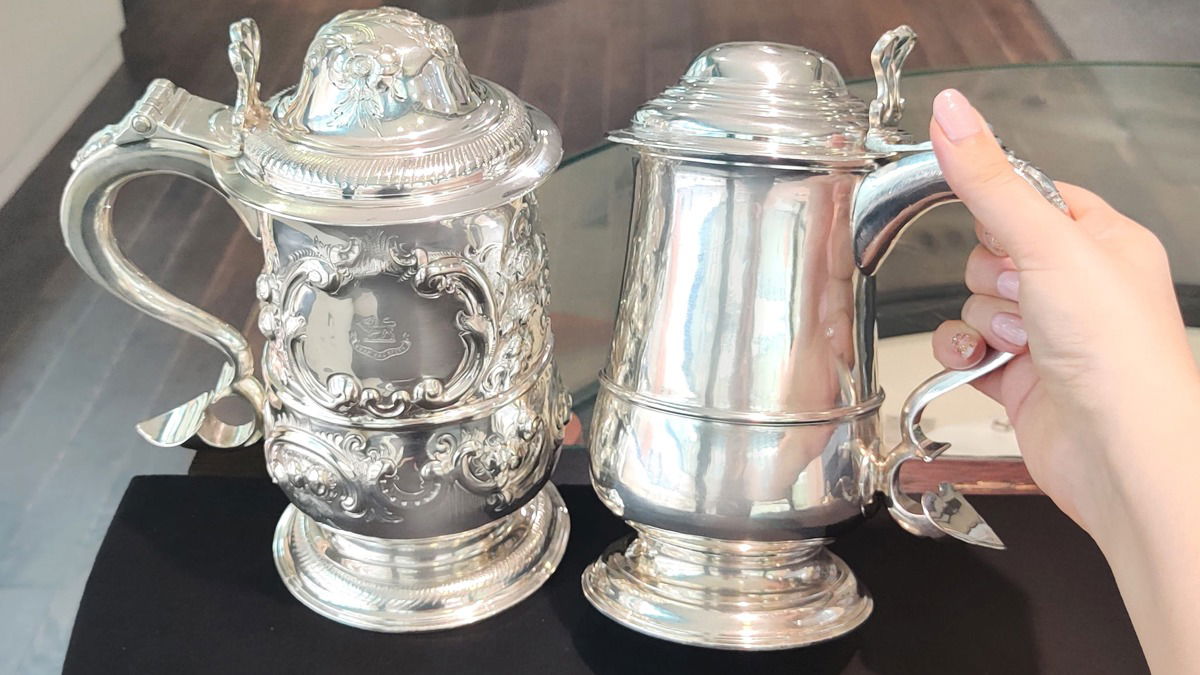Upon my time at AC Silver, I have been fortunate enough to be visually stimulated by art movements. Within each movement I have discovered certain items of silverware which have challenged my understanding and personal artistic logic. Today the piece I admire is a Georgian sterling silver tea caddy which is a rather rare example when it comes to the ornamentation.
This bright cut engraved decorated tea caddy is embellished with segmenting bands of classic organic designs accented with oval quatrefoil motifs. The anterior surface features a radiating cartouche bearing the contemporary engraved crest of a lion’s head, collared and erased. The rather unusual feature of this caddy is the four Chinese characters encircling the body, separated by the aforementioned borders.
Upon locating these characters, I collaborated with the highly experienced Chinese silver researcher, Adrien von Ferscht 皇甫安 BA; MBA, in order to portray an accurate translation for each segment within the product page description. I have requested Mr Von Ferscht’s assistance in the past for Chinese export silver hallmarks, as I have found his research archive to be an unparalleled resource to anything I have identified online.
The panels were translated as the Chinese symbols for the four seasons: spring (春 / chun), summer (夏 / xia), autumn (秋 / qiu) and winter (冬 / dong). With already such a rare design for a Georgian silver piece, it was not a connection I could have made without a thorough translation. Upon further conversation, we discussed that these symbols would classically be accompanied with decorative floral and foliate designs represented as the ‘Four Gentlemen’ (Chinese: 四君子, Sì Jūnzǐ). Within Chinese art, the Four Gentlemen is the cumulative term for four plants which – together – depict the development of the seasons through the year: the orchid (spring), the bamboo (summer), the chrysanthemum (autumn), and the plum blossom (winter).
Individually, these plants are commonly found on Chinese silverware, however, I have never made the connection with the four seasons – I personally connect a colour palette to a season. Not only do the seasons hold their own weather conditions and characteristics, the plants can also lend a hand to the symbolism. This alone makes me personally look at Chinese silver in a different way; wondering how the artist/silversmith used the association to influence the piece they made.
Winter – Plum Blossom
One of the most eye-catching flowers is the prunus, known for bursting into a fragrant and rich blossom in the midst of winter. Within the season, this plant cannot go unnoticed. The plum blossom, however, is not as striking, and composes itself with a more understated presence and elegance, serving as a metaphor for inner beauty, with a humble display under inimical conditions.
Spring – Orchid
The orchid is known worldwide as a beautiful and graceful plant; acknowledged for needing delicate care due to its fragile form. Often used as a symbol for beauty, nobility and strength, it bears similarities to the plum blossom as its fragrance is not overpowering.
Summer – Bamboo
Bamboo stalks are an iconic and structural design feature within Chinese silverware. These hollow stalks can symbolise open-mindedness due to their supreme flexibility and strength; this is also illustrated as a core human value by means of yielding but not breaking.
Autumn – Chrysanthemum
This flower blooms in the cold autumn air and signifies that winter is coming. With this, the plant can be used to represent the virtue of withstanding all hardships.
A Revelation
A result of my newfound knowledge was that I found myself scouring our selection of Chinese silver, examining each description I had written with great scrutiny to ensure I had correctly identified these plants on our other items. I’m no botanist, but in the past I have made do with the knowledge and resources available to me. This new information, however, needed to be applied wherever I was missing it.
Sure enough, I came across this stunning Chinese dish in our inventory. A beautiful example of oriental silver, it features eight decorated panels. Upon examination, I found three out of four of my Junzi (Gentlemen) listed in the description, and then found my discrepancy. When originally describing the item for our site, I had misidentified the final plant – an orchid – as an iris. I have since corrected my error, I am proud to report.
Although the tea caddy was the new item that brought the Four Gentlemen to my attention, it turns out they had been present at AC Silver for a lot longer than that. Furthermore, considering the fact that the Four Gentleman have been around since the Song dynasty (960 – 1279 CE), it seemed rude of me to have ignored them until now.
Special Thanks to Mr Adrien von Ferscht, whose knowledge and expertise were hugely helpful, read more of Mr von Ferscht’s research about Chinese Export Silver









